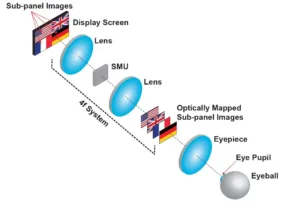Researchers Wei Cui and Liang Gao within the Department of Electrical and Computer Engineering at the University of Illinois (Urbana, IL) have developed a display system that produces a 3D image based on a technology called optical mapping. A principle virtue of the new approach is the claim that it can minimize the eye strain that derives from the mismatch between accommodation and convergence and that occurs in many display systems. By this means, the new approach could be used to make the extended use of VR/AR products less fatiguing.
A recent article on this topic published by the researchers is entitled “Optical mapping near-eye three-dimensional display with correct focus cues.” It was published in Optics Letters Vol. 42, Issue 13, pp. 2475-2478 (2017). A copy of the article is available for purchase here.
The new technology is explained with reference to the figure below.
The optical set up used in the optical mapping system.
The first element in the optical system is a digital display in which the screen is divided into subpanels that each present a 2D image. In the example illustrated in the figure above, there are four subpanel images. A so-called Spatial Multiplexing Unit (SMU) is then used to shift each of the four images to a different depth while aligning their centers along the viewing axis. In the current setup, the SMU is made of spatial light modulators that modify the light using an algorithm developed by the researchers.
When organized in this way, it appears as if each subpanel image is at a different depth when observed by a user looking through the eyepiece. The researchers also developed an algorithm to blend the subpanel images such that the depths appear continuous, creating a unified 3D image.
Although the optical mapping system could work using any one of several display technologies, the researchers chose an OLED display. The specific OLED display chosen was selected, in part, because it had an extremely high resolution. This criteria was applied to ensure that each subpanel contained sufficient pixel resolution to produce a good quality image.
Others Tried Time Multiplexing
In explaining the improvement achieved by their optical mapping approach, Gao offered this comment on the problems encountered by previously reported approaches: “People have tried methods similar to ours to create multiple plane depths, but instead of creating multiple depth images simultaneously, they changed depths, but instead of creating multiple depth images simultaneously, they changed the images very quickly.” He goes on to explain that “this approach comes with a trade-off in dynamic range, or level of contrast, because the duration each image is shown is very short.”
The researchers demonstrated the performance of the optical mapping display by using it to image a complex scene that included several parked cars. A camera was placed in front of the eyepiece to record the image as it would normally be seen by a user. “The experiment demonstrated that the camera could focus on cars that appeared far away while the foreground remained out of focus. Similarly, the camera could be focused on the closer cars while the background appeared blurry.” This test demonstrated that optical mapping display technology could “produce focal cues that create depth perception much like the way humans perceive depth in a scene.”
Current System is Mono – Color is coming
It should be noted that this demonstration was performed using only a black and white image. The researchers stated, however, that the approach could be extended to produce color images, although with a reduced lateral resolution. The researchers are now working to further reduce the system’s size, weight and power consumption. In addition, the researchers explained that “In the future, we want to replace the spatial light modulators with another optical component such as a volume holography grating.” The reason offered for the desire to pursue this specific alternative approach is that “In addition to being smaller, these gratings don’t actively consume power, which would make our device even more compact and increase its suitability for VR headsets or AR glasses.”
At this time, the researchers acknowledge that the technology has not attracted any commercial partners. None-the-less, they report ongoing discussions with companies to investigate the potential for the integration of optical mapping display technology into future AR and VR products. -Arthur Berman
University of Illinois, Liang Gao, 217-300-9930, [email protected]

